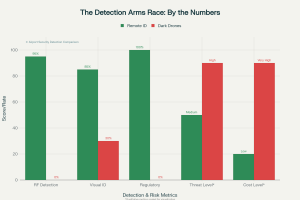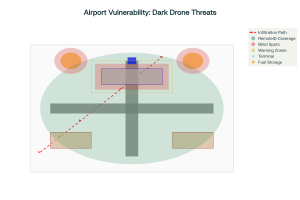While airports celebrate detecting 95% of Remote ID compliant drones, they’re missing 100% of the threats that actually matter. Last month alone, unidentified drone swarms appeared over multiple international airports, evading every detection system designed to protect them. These weren’t random hobbyist intrusions—they were sophisticated dark drones operating with military precision, invisible to traditional airport security.
The uncomfortable truth: airports are winning battles against regulated drones while losing the war against autonomous drone threats that bypass every current defense system.

Remote ID vs Dark Drones: The Detection Arms Race Reality
The 95% Success Rate That’s Actually a 100% Failure
Remote ID: The Regulated Advantage Creating False Security
FAA’s Remote ID mandate requires all registered drones to broadcast identification and location data, creating a false sense of comprehensive airspace awareness. Airport security teams report impressive detection statistics: 95% of drone encounters now provide immediate identification, operator location, and flight telemetry.
This success is masking a critical vulnerability. Remote ID compliance creates predictable drone signatures that make detection easy, but malicious actors aren’t filing flight plans or broadcasting their locations.
What airports are actually detecting:
- Recreational drones operated by compliant hobbyists (85% of detections)
- Commercial operations with proper Remote ID equipment (10% of detections)
- Lost or malfunctioning drones still broadcasting signals (5% of detections)
What they’re missing: Dark drones using waypoint navigation and RF silent operation—the exact threats that pose real security risks.
AirSentinel’s multi-sensor approach detects both Remote ID compliant and non-broadcasting autonomous drones, ensuring comprehensive airspace protection.
How to Turn Any $200 Drone into an Invisible Threat in 5 Minutes
Converting consumer drones to “dark” operation requires minimal technical expertise: disable Remote ID broadcasting, program waypoint navigation, and operate without controller communication. The modification cost? Under $50 in readily available components.
Dark drone capabilities that bypass airport detection:
- Zero RF emissions during autonomous flight operations
- Pre-programmed waypoints eliminating real-time control signals
- Low-altitude navigation below radar coverage thresholds
- Small radar cross-sections that blend with environmental clutter
European airports report that ground patrol teams discovered drones beneath stationary aircraft after detection systems completely failed to register them—drones that remained too small and low for traditional radar systems.

Airport Vulnerability Analysis: Critical Infrastructure Blind Spots
Why Airports Are Fighting Yesterday’s War with Tomorrow’s Threats
The Detection Technology Gap
Current airport security focuses on RF-based detection optimized for Remote ID signals, leaving critical blind spots against autonomous drone threats. Counter-drone systems worldwide are failing because they rely on outdated single-sensor approaches that work perfectly against compliant drones but fail completely against dark drone operations.
Detection Technology Scorecard:
|
Technology |
Remote ID Drones | Dark Drones | Airport Suitability |
|
RF Sensors |
95% Success ✅ |
0% Success ❌ |
High False Positives |
|
Radar Systems |
80% Success ⚠️ |
30% Success ❌ |
Expensive, Complex |
|
Optical Detection |
85% Success ✅ |
60% Success ⚠️ |
Weather Dependent |
| Multi-Sensor Fusion | 98% Success ✅ | 90% Success ✅ |
Optimal Solution |
The Threat Evolution Reality
Airport drone threats have fundamentally shifted from accidental incursions to intentional security probes. Dark drone capabilities expand monthly:
- AI-powered navigation avoiding detection patterns
- Coordinated swarm operations overwhelming single-target systems
- Environmental mapping identifying security blind spots
- Payload delivery capabilities for surveillance or disruption
The economic reality: The cost disparity between a $200 attack drone and million-dollar defense systems creates an unsustainable security model when detection systems can’t see the actual threats.
Airport Perimeter Security Gaps
Strengthening airport perimeter security requires addressing both visible and invisible drone threats. Current systems excel at tracking Remote ID broadcasts but fail at detecting physical drone presence—the fundamental requirement for airport security.
Critical infrastructure remains vulnerable:
- Fuel storage areas lack autonomous drone detection
- Air traffic control facilities rely on RF-only security
- Passenger terminals have visual detection gaps
- Cargo operations operate with limited airspace awareness
Immediate Actions: What Airports Must Do Now
Technology Investment Strategy
Successful airport drone security requires moving beyond Remote ID detection to comprehensive airspace awareness. Multi-sensor fusion combining radar, RF, optical, and acoustic detection provides 90%+ effectiveness against both Remote ID and dark drone threats.
Essential capabilities for 2025 airport security:
- Autonomous drone detection without RF signal dependence
- Multi-sensor verification reducing false positive rates
- Real-time threat assessment distinguishing malicious from accidental
- Integration architecture supporting existing security operations
AirSentinel’s advanced detection platform combines radar, RF, and optical sensors with AI-powered threat classification, providing comprehensive protection against both Remote ID compliant and dark drone threats.
Assessment and Implementation Checklist
Immediate Security Gap Analysis:
- ✅ Audit current detection capabilities against dark drone scenarios
- ✅ Test system effectiveness with non-broadcasting drone exercises
- ✅ Evaluate blind spots in critical infrastructure areas
- ✅ Review incident response protocols for unidentified threats
Technology Upgrade Priorities:
- ✅ Multi-sensor detection systems with autonomous drone capability
- ✅ Visual confirmation technology for RF-silent threat verification
- ✅ Integration platforms connecting detection with security operations
- ✅ Training programs for evolving threat landscape awareness
Future-Proofing Your Airport Security Investment
Autonomous drones represent the future of both legitimate airport operations and security threats. Detection systems must evolve to address both regulated Remote ID operations and unregulated dark drone activities.
The choice facing airport security teams: continue celebrating Remote ID detection success while remaining vulnerable to dark drone threats, or invest in comprehensive airspace protection that addresses the complete threat spectrum.
Ready to close your airport’s dark drone detection gap? Contact AirSentinel for a comprehensive airspace security assessment and learn how our multi-sensor platform provides complete protection against both Remote ID and autonomous drone threats.
FAQ
1. What are dark drones and how do they differ from Remote ID compliant drones?
Dark drones are non-compliant drones that operate without broadcasting Remote ID identification signals, making them invisible to traditional detection systems. Unlike compliant drones that broadcast location, speed, and pilot information via Remote ID, dark drones use pre-programmed GPS waypoints, fiber optic communications, or RF-silent operation to avoid detection. These modified consumer drones can be converted in minutes by disabling Remote ID broadcasts.
2. Why are airports losing the detection arms race against unauthorized drones?
Airports detect 95% of Remote ID compliant drones but miss 100% of the threats that actually matter. Dark drones evade traditional RF detection systems by operating autonomously without controller communication. Recent incidents show sophisticated drone swarms appearing over international airports with military precision, bypassing every current detection system designed to protect them. Only radar systems can reliably detect these RF-silent threats.
3. How easy is it to convert a regular drone into a dark drone?
Converting consumer drones to dark operation requires minimal technical expertise and can be done in five minutes. Operators simply disable Remote ID broadcasts, program GPS waypoints for autonomous flight, and use RF-silent communication methods. Online modification software allows drones to fly higher and longer than original capabilities. This accessibility makes detection evasion simple for malicious actors.
4. What detection challenges do dark drones pose for airport security?
Dark drones create blind spots in RF-based detection systems that rely on signal broadcasts. Environmental factors like weather, terrain, and electromagnetic interference further reduce detection accuracy in coastal and urban airport locations. Traditional detection systems struggle with varying drone sizes, speeds up to 100 m/s, and dynamic flight patterns that mimic birds or other aircraft. Over 90% of reported sightings are misidentified objects.
5. What solutions exist for detecting non-compliant dark drones at airports?
Multi-sensor fusion combining radar, RF detection, optical cameras, and acoustic sensors provides comprehensive coverage. Radar remains the only technology capable of reliably detecting RF-silent drones over large areas with 3D dome coverage. Advanced AI algorithms and machine learning improve tracking accuracy for dynamic drone behaviors. However, legal restrictions prevent airports from actively neutralizing detected threats without proper authorization.